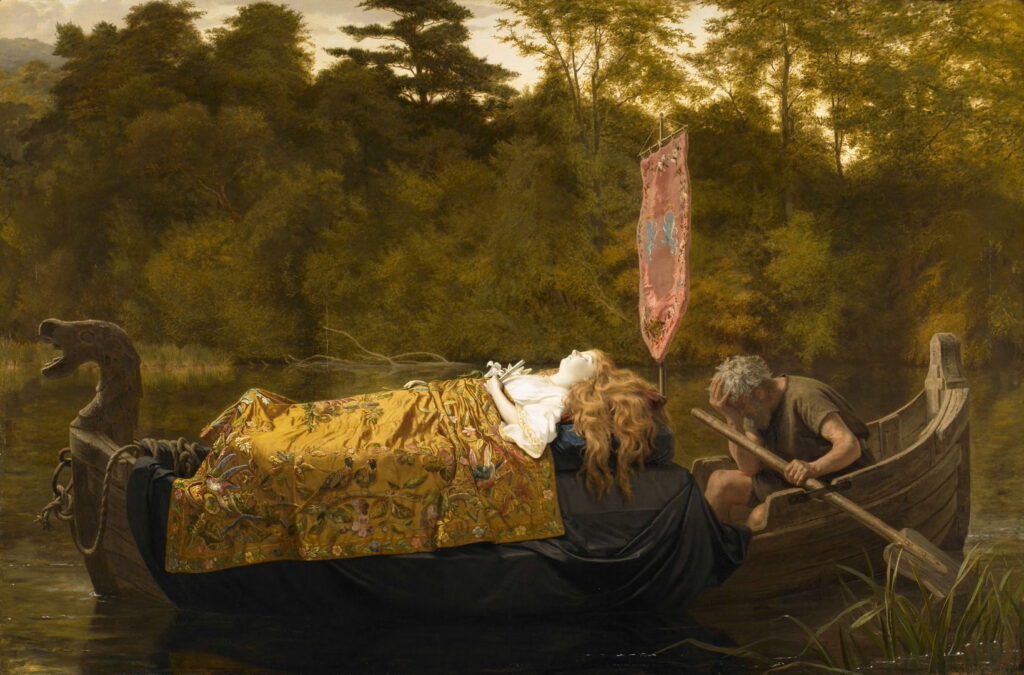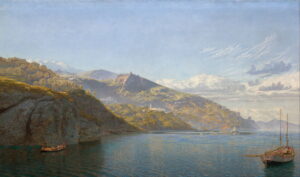Arthur: 10 Elaine of Astolat

After the the quest for the Holy Grail had been completed, the surviving knights of the Round Table returned to Camelot. Malory tells the story of Lancelot’s intensified affair with Queen Guenevere, and a poisoned apple. Following that, King Arthur announced a great tournament to be held at Camelot; because of his affair with the Queen, Sir Lancelot decided to appear there in disguise. He travelled to the town of Astolat, where he stayed with an old baron, Sir Bernard of Astolat, who lent the knight armour, colours and a shield to preserve his anonymity.
Bernard’s daughter, Elaine the Fair Maid of Astolat, fell in love with Lancelot, and asked him to wear a token of her affection when he was at the tournament. Although he was initially reluctant, he agreed to wear her scarlet sleeve embroidered with pearls. He then entrusted Elaine with his own shield before riding off to joust at the tournament.
Eleanor Fortescue-Brickdale (1872-1945), Elaine of Astolat (c 1913), illustration in ‘Idylls of the King’ (1913), further details not known. Wikimedia Commons.
Eleanor Fortescue-Brickdale shows Elaine of Astolat in her illustration for the 1913 edition of Tennyson’s account of this story in his Idylls of the King. She sits sewing in the family castle, guarding Lancelot’s shield.
Edward Reginald Frampton (1870-1923), Elaine, the Lady of Shallott (1920), oil on canvas, 63.5 × 38 cm, location not known. Wikimedia Commons.
Despite its confusing title, Edward Reginald Frampton’s Elaine, the Lady of Shallott (1920) shows a similar scene, with Lancelot’s shield tied to a lectern.
John Melhuish Strudwick (1849–1937), Elaine (1891), oil on canvas, 79 × 58.5 cm, Private collection. Wikimedia Commons.
John Melhuish Strudwick’s painting of Elaine from 1891 is more ambiguous: although Lancelot’s shield is shown in front of Elaine and is clearly an object of some veneration, in the background to the left there’s what appears to be a loom, and the shield could perhaps be interpreted as a mirror, both of which are more evocative of the story of the Lady of Shalott (covered in the next article).
Although Sir Lancelot triumphed at the tournament and impressed King Arthur and others with his deeds, he was wounded in the side and wondered if that injury might kill him. He was helped back onto his horse and rode a couple of miles to reach a hermit with great healing skills. As Lancelot stayed there to recover from his wound, Sir Gawain visited Bernard and his daughter Elaine and, from the shield she was guarding, discovered Lancelot’s identity. But when Gawain told Arthur, the king revealed that he had known this all along, as he too had stayed with Bernard. Queen Guenevere, though, was beside herself with anger when she discovered that Lancelot had worn the sleeve given to him by Elaine of Astolat.
Meanwhile, Elaine discovered Lancelot recovering from his wound in the hermitage. At first she swooned at his condition, but decided to stay and nurse him back to health. Sir Bors, who had inflicted the wound that had nearly killed Lancelot, came and apologised to the knight, and told him of Guenevere’s jealousy at Elaine’s affection.
Time passed and Lancelot recovered. He, Sir Bors and Elaine then returned to her father in Astolat. When Lancelot was preparing to leave, Elaine pleaded with him to marry her, but he even refused to be her lover. She warned him that she would die for her unrequited love. As Lancelot left her, Elaine fell into a swoon, and faded away. After ten days she received the last rites, then dictated a letter and gave instructions that, when she died, she was to be put into a fairy bed, conveyed to the River Thames, and there put into a boat steered to Westminster by one man.
When she died, her wishes were followed by her father and brothers, who placed her in a boat with one of their servants, who was also stricken with grief at her death.
Sophie Gengembre Anderson (1823–1903), Elaine (The Lily Maid of Astolat) (1870), oil on canvas, 158.4 x 240.7 cm, Walker Art Gallery, Liverpool, England. Wikimedia Commons.
Sophie Gengembre Anderson’s Elaine (1870) is shown making that final journey, her dead hands holding her last letter and lilies. As with all paintings of this phase of the story, she is dead when placed in the boat, and accompanied by the single servant.
King Arthur and Queen Guenevere saw Elaine’s boat and sent knights to bring it in and moor it alongside. Arthur took the letter from Elaine’s hands and had a clerk read it aloud to his court, who wept in sadness at the young woman’s death. Sir Lancelot was summoned to hear the letter, and the king told him to ensure that the Fair Maid was buried with honour. Queen Guenevere asked Lancelot for mercy over her previous anger towards him.
Artist not known, The Lady of Shalott reaches Camelot (before 1887), oil, dimensions and location not known. Wikimedia Commons.
It’s not known who painted this, The Lady of Shalott reaches Camelot (before 1887), but Elaine’s body, complete with flowers and letter, and accompanied by the servant, has arrived in front of Queen Guenevere, King Arthur and their court.
Lancelot Speed (1860-1931), Elaine in the Barge (1912), illustration in ‘The Legends of King Arthur and His Knights’, 9th edition, ed. Sir James Knowles, Frederick Warne and Co. Wikimedia Commons.
Lancelot Speed’s illustration of Elaine in the Barge, for a 1912 edition of The Legends of King Arthur and His Knights, shows a modest depiction of the same scene, here including the clerk reading out Elaine’s letter.
The account I have given here is summarised from Malory’s; between 1859 and 1885, Tennyson published Idylls of the King, a cycle of twelve narrative poems based on Malory. One of those poems, Lancelot and Elaine, tells this story of Elaine of Astolat, and leaves Lancelot wondering whether Elaine’s love had been more true than that of Queen Guenevere.
Tennyson was also among those who told a similar story that isn’t included in Malory, of the Lady of Shalott, the subject of the next article in this series.
Reference
Dorsey Armstrong (translator and editor) & Sir Thomas Malory (2009) Morte Darthur, a new modern English translation, Parlor Press. ISBN 978 1 60235 103 5. (A superb translation based on the Winchester manuscript.)




